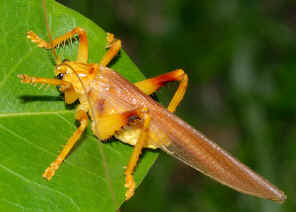Spider Face Leaf-rolling Cricket - Nunkeria brochis
Family GRYLLACRIDIDAE
This page contains pictures and information about Spider Face Leaf-rolling Crickets that we found in the Brisbane area, Queensland, Australia.

- Male, body length 50mm
- Spider Face Leaf-rolling Cricket is reddish brown to orange pale brown in colour with fully developed wings. It has very long antenna, all legs are spiny. The median ocellus of the cricket is very large. The cricket hides in nest on tree during the day. Their nest is usually two board leaves hold together by silky material. They are well known for their ability to find the way home after foraging distance away.
- The Cricket has a dark face pattern resemble the spider's face, i.e., a pair of large fangs, group of compound eyes. The mandibles are extremely elongated. It mimics spider behaviour as well. Details are discussed as below.



- We found this male Raspy Cricket on Nov 2008, when it was hiding in nest during the day.


- We did not found a female yet. From reference information the adult males and females looked the same except females have the sword-like ovipositor. They are medium in size with slender body. Both adult male and female are fully winged.
Male
Mimicking Huntsmen Spider
- On a early summer day afternoon, Nov 2008, while we were looking for butterfly caterpillars in Wishart bushland near Bulimba Creek, we noticed something was hiding between two leaves, two board leaves which were attached by silky material. We thought it could be a Tree Huntsmen Spider.



- Slightly opened the nest entry, we saw a pair of large fangs, group of compound eyes, almost certain that it was a Tree Huntsmen Spider. The "spider" posted an attacking posture. We retreated to avoid being bitten. We carefully approached the nest again and prepared to take some photos.



- Holding the branch and opened the nest a bit more, the "spider" expanded to double its body size. We were frightened again and did not know what it was. We released the branch and retreated again. Carefully inspected the insect in a distance, we recognized it was a Raspy Cricket. The large fangs and group of compound eyes were just the pattern on the cricket's face. The suddenly increased in body size was due to it fully extended their wings and legs. Checking the references and found that it is a common defence mechanism of Raspy Crickets and some other species in insect Order Orthoptera.



- We noticed the other tree cricket's face pattern long time ago. Both female and nymph have the same pattern on their face. However, we did not know if the pattern has any uses. We had just suddenly realized that the patterns on this cricket is for spider mimicking. Their nest look the same as the Tree Huntsmen Spider's nest, it can be easily understand that it is the evolution force to shape their face pattern and behaviours to look like a tree huntsmen spider. (We have more about insect mimicry here.)
- After both mimicry and "double size" defence mechanisms were not quite working to us, the Raspy Cricket quickly run away and hide under leaves. It did not try to fly away. We suspected it was not able to fly. Although its wings were fully developed and large, both front and hind wing membranes were very weak.
- Rosalie left message in our Blog about their experience with this Striped Raspy Cricket : "It was on a passionfruit vine and when I approached to show it to our grandson, it did the warning trick of becoming a spider. We were both entranced at the change it could perform by simply flipping over to display its underside. It also held its front legs in a very spider-like pose, and 'struck' at us as if to bite. What an amazing adaption."
- Reference:
- 1. Insects of Australia, CSIRO, Division of Entomology, Melbourne University Press, 2nd Edition 1991, pp 380.
- 2. Studies in Australian Gryllacrididae: Taxonomy, Biology, Ecology and Cytology - Rentz DCF, John B. 1990. Invertebrate Taxonomy 3: 1053-1210.
- 3. Gryllacrididae - Insects of Townsville, Australia - Graeme Cocks.
- 3. Grasshopper Country - the Abundant Orthopteroid Insects of Australia, D Rentz, UNSW Press, 1996, p62, plate46.
